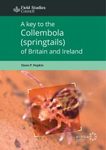![Synopses on Palaearctic Collembola, Volume 7, Part 1: Capbryinae & Entomobryini Synopses on Palaearctic Collembola, Volume 7, Part 1: Capbryinae & Entomobryini]()
Click to have a closer look
About this book
Contents
Customer reviews
Related titles
About this book
From the introduction:
"This volume of the Synopses on Palaearctic Collembola is a review of the subfamily Capbryinae and the tribe Entomobryini belonging to the family Entomobryidae. We have studied up to 13 000 specimens belonging to 270 species out of 11 genera. They have been
described and drawn, taking into account older sources as well as the recent literature. Geographically, arctic species are included as well as species from the Chinese-Japanese region, the Himalaya and North Africa.
The specimens examined come from many national museums, universities and scientific institutions around the world and from some private collections. For the study and description of each species, we have tried to use the types. For about 40% of all cases this was not possible due to lack of response from the institutions where the types are stored, sometimes the types have been lost or they are in poor condition. In these situations, we have tried to obtain material from sites close to the type locality or recent descriptions of the same species. In some occasions we had to recuperate dried specimens with a methodology described below. The types of older material were often very difficult to examine; frequently it was necessary to remount them, but this was not always possible, although some museums have given the permission to do so.
For many species of the family Entomobryidae, frequently erroneous citations have been published over the years. This was because the species identification was based on the colour pattern, but there is a great range of variation in some widespread species, and many other species are known only from the type locality.
For these reasons the information given on distribution, biology and ecology must be taken with some reservation, except for those species that are well-known and widely distributed. This book is not intended as a collection of papers or extensive descriptions about each of the species. I rather tried to provide an original work with the full description of the chaetotaxy of the species (if possible), extending the enormous work done by Szeptycki (1979) on the chaetotaxy of some species to all species studied in this book. However, I attempted to simplify the character pattern he proposed, and have taken into account only some of the segments and areas on the tergites that Szeptycki had introduced.
During my study of the specimens, several new species were discovered. These have been described and published in scientific journals over the years. [...] The review ends with species published by the end of 2011."
Contents
1. Introduction 3
2. Methods 5
3. Order Entomobryomorpha 16
4. Superfamily Entomobryoidea 20
5. Family Entomobryidae 20
6. Subfamily Capbryinae 20
7. Subfamily Entomobryinae 24
8. Tribe Entomobryini 24
9. Genus Coecobrya 25
10. Genus Drepanura 56
11. Genus Entomobrya 68
12. Genus Entomobryoides 209
13. Genus Himalanura 213
14. Genus Homidia 227
15. Genus Marginobrya 290
16. Genus Mesentotoma 290
17. Genus Prodrepanura 295
18. Genus Sinella 299
19. Habitus figures 323
20. Bibliography 370
21. Index of genera and species 385
22. Acknowledgements 390
Customer Reviews



























